Antique Honey Amber Star Spring Co. Mineral Water Saratoga NY Pint Bottle
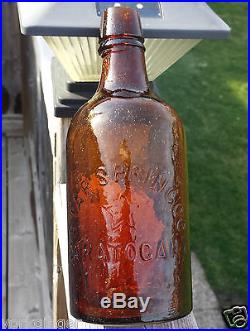
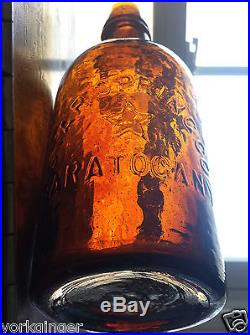
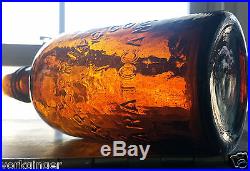
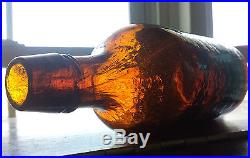
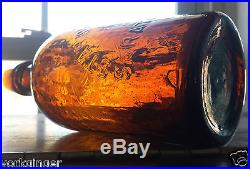
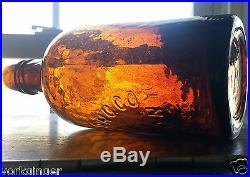
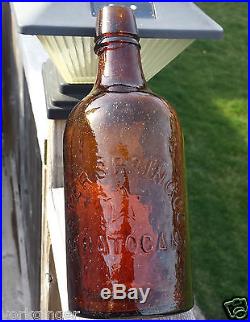
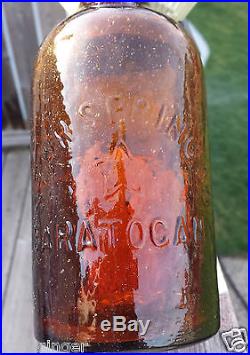
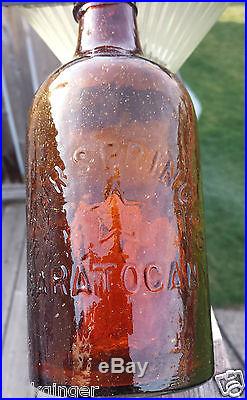
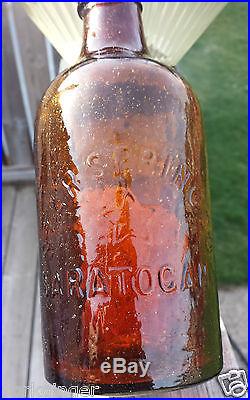
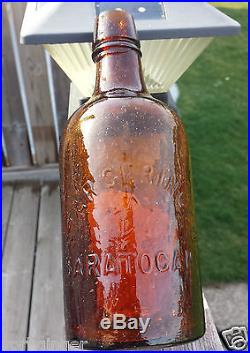
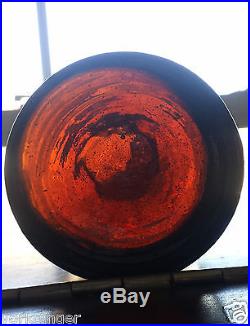

Mineral Water Saratoga NY Pint Bottle Only! Bottle Measures 7 3/4 inch Tall And Dates From 1860's to 1870's.
Mineral Water Glass Bottle Has Hundreds of Air Seed Bubbles, Widdle Marks in The Glass and is in Near Mint to Mint Condition. PLEASE CHECK ALL PHOTO'S FOR FURTHER CONDITION. You are welcome to use checkout, or you can request an invoice from us if you prefer. Is expected within 7 days. Check out my other items.
2016 Toronto Bottle Show, Sunday April 17th. Toronto Bottle Show and Sale hosted by the Four Seasons Bottle Collectors Club. Was held at the Pickering Recreation Complex again, and once again this year the. Show was really well attended.
Admin reports that 263 people paid. Dealer tables this is Canada's b. Bottle show and sale offering a huge selection of antique bottles, pottery and related collectibles. The poster says No crafts, reproductions or early admission. But there are of course some reproductions. Are historic in their own right.Ll point them out in th. Ten minutes before the doors opened, and couldnt find a parking spot in the adjacent lot. Had to park across the street. It was an absolutely gorgeous spring day and the first nice Sunday we've had in a while - a great day for a bottle show.
Outside the front entrance of the hall. The show needs better signage. In the lottery I w.To the next Toronto B. Each of the sixty five deale.
And so when i ask vendors t. This is what I'm thinking.
New favourite squat soda water bottle, JAMES CORDERY / LONDON. And bottles to focus on. There are about ten really hard to find Ontario squat sodas dating from the middle to late 1800s that he doesn't already hav.
And for which he keeps an eye. At every show he attends. Sean has set an achievable goa. What flavour was the soda pop in this small bottle? That is a question for the ages; in truth it could have held any flavour, or many flavours like so many other squat sodas there's no clue to the maker's flavour on the glass.Period advertising is often the on. Ly way modern collectors can know. The historic producer's signature blends.
Sam Stuart with a large collection of relics from the Ontario Forest Board. I got a picture and I could put it here, but it just looks like a rock. The rock that is in fact a 10,000 year old hand tool. A drugstore sign from the early 1900s advertising Dr.Wrote about here in 20. Remarking on its popularity as a found antique (while reminding readers that its pretty much worthless as a collectible). Price at the show - it was just held up. On a whim for the camer. These guys are from Ottawa and they are pillars of the Eastern Ontario bottle collecting community and long standing members of the the Bytown Bottle Collectors.
Club who are having a show next week. April 24th 2016 in Ottawa. Show is only ten percent smaller than the Toronto show on paper. The Four Seasons Show in Pickering has sixty five tables and Ottawa has only sixty. These guys always have really old, highly obscure and super interesting medicines which is what Scott collects.
Look here at the lovely paper label amber Ryckman's Kootenay Cure, which is very much like Dr Thomas Eclectic Oil in that it's a patent medicine, also known as a nostrum (from the Latin nostrum remedium, or "our remedy") is a commercial product advertised (usually heavily) as a purported over-the-counter medicine, without regard to its effectiveness. Ryckmans Kootenay Cure was manufactured in the mid-1890s by a Member of Parliament with mining interests in the Illecillewaet district southeast of Revelstoke. He said that on a visit to one of his gold mining claims near the headwaters of the Incomappleux River, an old miner gave him a recipe for a rheumatism cure. The potion, which also cured blindness, deafness, indigestion, gout, eczema, skin disease, hives, sores, liver and kidney disorders was made from plants found in the area.
Was cranking out cases of the Kootenay Cure, and filling newspapers with testimonials. John Dunbar holds up a lovely Dutch onion. John Dunbar has been collecting since he was kid and one of his oldest and most prized possessions is this dark green onion bottle. John acquired the collectible from a frequent visitor to Surinam. Would have had a cork and lead foil.
Contained French or German wine on its voyage south. Epending on the company it could have been refilled with rum for a return voyage. Early in the day I encounteredJanet Gilbert and her husband Mark Gilbert who came seeking bottles, jugs and crocks with the name'Swan' for the creation of a family museum. They had pics of antiques they knew existed, and so they asked dealers'have you seen these items? We know Swan Bros were grocers in Toronto who left their name on some jugs and crocks.
Some history appears on online at Worthpoint. Was Henry Swan one of the Canadians who marched to Fort Erie. To put down the Fenians? And her subsequent follow-ups with club members.
About winning and look for my favourite objects o. The town of Port Perry came up in conversation again as I interviewedRick Adams and his wife Gail who drove down from Huronia, all the way down to Pickering to showcase Ontario heritage with stoneware items like this uniquely misshapen giant six gallon pickle crock. The piece is stamped S. SKINNER & CO / PICTON C. W stands for Canada West and that's what makes it so darn historic and valuable to collectors.That means it was made before Confederation in 1867 which is when the province of Upper Canada was renamed Ontario precisely because it would be too confusing to have the province of Upper Canada or Canada West occupying the bottom middle of a nation called Canada. Was there ever a lid? Would it be also be misshapen like the crock? Did it have a lip and make a seal? The item is really sturdy and weighs over ten pounds.
Douglas Dopko was at the 2016 show. These vessels on his table were otherwise contained in four heavy Tupperware containers behind him, and his objective was to bring home lighter crates.
They told me about the biggest dump they ever encountered, a ravine dump between two farms they picked through in the 1970s and early 1980s. After some scouting around in their glass, Ifound the best piece on their table was not a dug item at all but rather this Captain Morgan Gold Label Rum bottle which has the date on which it was consumed, Friday the 13th of February 1952 scrawled on its paper label. That was a rum day for someone. Bob Harris, always a highlight of my report, lit up the entire 2016 show with his antique coal oil lanterns. Id like to believe it was because it was advertised so well inthe Dumpdiggers' 2015 Toronto Bottle Show.
Blog post which features him holding up that smashed tackle box, but we'll probably never know. This year Bob and his wife brought kerosene lamps, or are they'coal oil lamps'? The oldest ones used whale oil I suppose, but of course Bob didnt have any that ancient.
These are from the last great age of oil lanterns when they were mass produced glass and metal fixtures in the house, present in every room, and in every dept store home furnishings catalog. The models all had names like Princess Feather and Bullseye and Canadian Drapes. Interesting enough to send me on a research binge for a few minutes is that'Princess Feather' is a respected design theme its own right. Its a design motif most present in quilting.
I'm going to do something I never do in this post and that's borrow an image from another blog. The image to the left is from Karen's Quilting blog. Andin her write up she refers to circles made by connecting eight'princess feathers' around a central flower blossom. So the takeaway for me is that a'princess feather' is an actual'swoosh' feather design that may or may not be derived from a feather on a Heraldic banner. At any rate what we see on Bob's lantern below is a much more exaggerated swoosh.
The princess feather below is a vertical feather curl almost like a fiddle head. Bob tells me the oldest Princess Feather kerosene lamps didnt have the central flower blossoms you see on reproductions. To the right is a repro that is a valuable antique in its own right. The piece is over sixty years old, still functions and is a beautiful decorative furnishing that looks great by the window.
The lanterns came in five different sizes and Bob had three sizes of Canadian Drapes oil lamp varietals, including the smallest which he was proud to report still has its original chimney, or at least a glass chimney that fits the lamp base which he identified as'vintage' by its peculiar style of decorative crenelations at the top of the chimney, see below. So after all that I asked, Bob when did they stop making these things? And he said Theyre still making them! But who knows, it doesnt mean they wont sell later! Tim Maitland and his father Jim Maitland almost always have the biggest milk bottle spread of the show with hundreds of vintage silkscreen vessels set out in front of them at their table.But today Tim held up a 16oz cobalt blue'coffin poison' bottle marked POISON / CARBOLIC ACID / USE WITH CAUTION instead of a rare dairy bottle. The letters'OCP' embossed on the bottom denote the vessel belonging to, or originating from (or as being subjected to legislation and enforcement governed by) the Ontario College of Pharmacy.
Carbolic Acid poisons resulted directly from the efforts of the Ontario College of Pharmacy (OCP) to oversee the sale of that chemical. Around 1910-12, it became provincial policy, as per the regulatory initiatives of the OCP, that Ontario pharmacists had to put up carbolic acid in these specially designed bottles. They come in 1/2, 1, 2, 3, 4, 6, 8 and 16-ounce sizes. Besides being embossed with "Carbolic Acid" on their fronts, they also have O. (for Ontario College of Pharmacy) embossed on their bases. Other provincial pharmacy boards in Canada also adopted their official use. So what the heck do people do with carbolic acid anyway? The nearest I can figure is that it was a common antiseptic and was used in the fight against dysentery and infection in hospitals and clinics. John Findlay brought some Brewerainia to the bottle show. He chose to hold us a hard to find Dawes Black Horse Ale and Porter tavern sign that is not featured in the online catalog or museum. It would have been prominently displayed to impart the brand name and logo to induce consumers to order the product.Dressed in orange and surrounded by orange collectibles were Michael Rossman and his wife Janice. They're the'Orange Crush couple', and I have written about him and his valuable book Orange Crush - Krinkly to Mae West at least once before. Here's a link to the 2011 Toronto bottle show. Where you can see his offerings on display. The couple also brought early carrying cases and serving trays and period advertising under glass.
They also had a superb six glass set of Orange Crush drinking glasses from the 1960s. He started in the St. Lawrence when it was so murky you couldnt see twelve feet in front of you. Now with Zebra Mussels its clear as day down there apparently, but there's nothing left to find. Gary had two valuable pieces perched precariously at the top of his. In the photo above Gary holds his STARR BROTHERS / BROCKVILLE soda that dates from between 1860 - 1872.This vessel, he claims is the only known example, and. Gary is an expert on bottles and relics from Eastern Ontario. He has been known to speak to citizenry about local bottles that are the legacy of their commercial trade. In 2013 he was featured in a local newspaper celebrating Brockville's heritage.
Is Canada's foremost torpedo bottle collector. But this year he chose to display a teapot. Near the end of the day I drifted over to Terrys table to see what he'd brought for me, and same as last year he had a rare item glazed in either Rockingham or Bennington that was a museum quality piece.Indeed, Terry's teapot is similar to a piece found in the Royal Ontario Museum which they describe as A variant form, the unmarked beaver and maple leaf teapot here does not conform to any excavated sherd or lids, th ough the piece as a whole is remarkable similar. While it could be a style of the post-1883 period, its relative heaviness and clumsiness suggest its an earlier Welding version c. 1875 - 1880 and a predecessor of the excavated form. And same as previous years this item was not for sale - Terry was offering his insights on the historically significant item as gift to knowledge seekers and Dumpdiggers blog readers.
Over the years I've covered Ron's table and shown his Sproat torpedos, and even singled him out as having the most valuable bottles at the show. He bought theeight panel cobalt blue soda seen left that was made between the years 1850 and 1862 - Henry Sproat is listed in the red book as'Ginger beer maker'. You can gaze upon the H SPROAT torpedo soda bottle here in Tim Braithwaite's collection.Courtesy of Early Canadian Bottle Works, Darren's website. Or now that I think on it, its more likely doesn't want to make public exactly what he'd just paid for the piece. And Ross Wainscott sitting behind a table full of fruit sealers. The Burlington with its matching.
The 2016 Toronto Bottle Show was great fun as always and thanks for everyone who deigned to pose for my camera. At the end of the show.
A perfect stranger to pose beside the front entrance sign. The pic didn't really turn out the way I wanted; it didn't lead, but its a good image for the close. Thanks all - Good work Club Members. PLEASE CHECK ALL PHOTOS BELOW! June's Giant Gurd's Display Stoneware Ginger Beer Bottle.
Charles Gurd was a Protestant Irishman who came to Montreal as a child and lived in Griffintown and watched three older siblings die in terrible living conditions before he himself triumphed and launched a hugely successful soft drink company. Another line of local Gurds were hugely influential in local medical history, although sadly the last of that line was five daughters dispersed outside the city. Here's a couple of articles about the company written during the War.
Not sure when Gurds went belly up but from what I can tell the great grandson, an architect who lives here in Montreal and Vancouver, isn't hurting for cash. Gurd's, Established in 1867 Has Developed With NationMontreal Standard May 15, 1943 The dominion of Canada was only ten months away from the triumph of Confederation when Gurd's beverages first made their bow to the public and Charles Gurd and Company started a corporate career, that step by step has matched the growth of this nation. The founder, who gave his fame to the firm, came from Ireland at an early age, was educated here, graduating in chemistry from McGill University.To his new business he brought the assets of his bounding energy, enthusiasm and imagination. He had great faith in the new Dominion and he set out to show the world that within its borders could be procured ginger ales, ginger beers, soda waters and other such beverage equal to any that could be imported. Business grew extraordinary rapidity, and the first factory located on Jurors street, now known as Vitre, soon became too small and the first of many moves of expansion began.
The products grew in number; output increased rapidly. The present Bleury street plant was completed in 10912, but a final addition going up some years later.
Outstanding among the late Mr. Gurd's qualities was his progressiveness. He wanted "The best" and saw that he got it.
The syrups and essences that went into his beverages were selected with meticulous care. His plants were always the most modern in methods and equipment and the intense loyalty that he put into his business was reflected in his employees. Gurd's founder did not confine his interests solely to his business.
He considered every citizen worthy of his salt owed something to his country and community. He was extremely active in church and hospital work and took a great interest in music, being one of the original members of the Mendelsohn Choir.
He was also one of the originals of the Victoria Rifles of Canada and one of the early presidents of the Dominion Commercial Travellers' Association. Today, war conditions have imposed severe restrictions on the operations of Charles Gurd and Company. Acute shortage exist in many necessary materials but with characteristic foresight, plans were laid as far back as 1939 to counterbalance the probable effects of wartime by providing new products. A food Division was established ans is now packing large supplies for overseas as well as civilian needs.
The present Directorate of the Company is as follows: L. Gurd Firm marks 75 th anniversary200 Officials, Employees Celebrate event with program and dance Gazette 17 May 1943 Long Service Rewarded -- History of Beverage Concern from Founding in 1868 by Charles Gurd is Reviewed by speakers The three-quarter century mark in the life of Charles Gurd & Co. Limited was fittingly celebrated at the seventy-fifth anniversary dinner in the ball room of the Mount Royal Hotel Saturday night, when about 200 officials and employees of the company and their guests enjoyed a program featured by appropriate addresses, the presentation of gifts to employees for long serve records, dancing and a floor show. Vezina, company president and director, was chairman and toastmaster of the evening. Other head table guests were: Col.Perrier sales manager; Harry Smith, advertising counsel; Robert Paul, William Paul, Paul Dionne, Alex Rosa representing English-speaking salesmen; Charles Cowan, employee with the longest service; Auguste Daoust, representing French-speaking salesmen; Miss B. Owen, representing the office staff; Joe Potchinok, representing the factory staff, all the foregoing having the longest recod of service in their departments; W. Gay, advertising manager, Montreal Standard. Toasts were proposed to employees on active service by Col E.
Hanson; to the guests by R. Perrier, with Paul Dionne, president of A. Dionne & Sons Limited, responding to the founder of the company, by J. Murphy responding, and to The King.
Long service awards were made by Mr. Vezina to the following: C.
Cowan, 38 years; Al Daouest, 37 years, A. Lemieux, 35 years, Joe Potchinok, 33 years, R. Perron, 20 years, Leon Larivee, 17 years; W. Rivard Julmphy, 15 years; Albert Welter, 14 years; R. Masson, Maurice Larivee, 12 years; A.
Charette, 10 years; Thomas Schmidt, nine years; Leslie Lummis, eight years; Willie Poitras, Leo Herbert seven years; Albert Wise, Arthur Dube, M. Charlebois, Paul Belanger six years; John Daoust, five years. Perrier, sales manager who is in charge of the Victory Loan campaign among the employees with a certificate indicating that the employees had exceeded their loan quota. When Gurd's beverages first made their bow to the public on May 1, 1868, the Dominion of Canada was only 10 months old, fresh from the triumph of Confederacy still unco-ordinated and cautiously feeling its way towards the future. It was an age of enormous optimism, rapid expansion, vast uncertainties, magnificent plans and astonishing achievements.
Born in Edgeworstown, County Longford, Ireland, the late Charles Gurd the founder, came to Canada as a child and was educated at the Montreal High School, at Watson's Academy and at McGill University. His business grew with extraordinary rapidity, and the first factory, on what was then known as Jurors street (now Vite) diagonally across from the present Bleury street site of the modern Gurd plan, soon became too small and he moved across Bleury to a vacant former police station. In 1893 he had 21 different products entered in the Montreal exhibition. The old Bleury site is now the back yard of the present plan. A new factory then sprang up behind Hermoine and Jurors streets giving place in its turn in the Bleury street plan, completed in 1912 that now houses the offices of the company, while a still more recently acquired property on Lagauchetiere street provides ample space for production.Gurd, whose successive plants were always the most modern of their period. This intense loyalty that he put into his business was reflected in his employees who remained and progressed with him.
He didn't confine his activities solely to business, however, but was extremely active in church and social work, and his interest in music led him to become one of the original members of the Mendelssohn Choir. He was also one of the original members of the Victoria Rifles of Canada and was one of the early presidents of the Dominion Commercial Travelers' Association. In 1906 he turned his private business into a limited company of the closed corporation type, taking the immediate members of his inter partnership with his nephew, the late Alex McA. In 1927, the business became publicly owned, when it was bought by a strong financial syndicate. Gurd remained as president until his death two years later, and was then succeeded by his nephew, Mr.
Murphy, who saw 52 years' services with the firm, retiring in May and dying that same year. With characteristic foresight and adaptability, plans were made late in 1939 to counterbalance the probable effects of wartime conditions on beverages by providing new products of timely value. A food division was established and has made marked progress and in addition to civilian business is now packing large supplies for the armed forces, particularly of hot chocolate drink. Bottles of Quebec - Steve Lussier Collection.
Wanted - Ginger Beer Bottles! Three of the Largest Stoneware Manufacturers in the United Kingdom.Manufactured Stoneware Ginger Beer, Beer bottles and Stoneware Whisky Jugs. Henry Kennedy operated the Barrowfield Pottery. The impression is near the base of the bottle. Manufactured Stoneware Ginger Beer, Beer bottles and Stoneware Jugs.
This works was started in 1828 and operated under various owners until it was taken over by James Miller as James Miller & Company. By 1857, it was organized as the Port Dundas Pottery Company. In 1866, steam power was introduced to turn the potter's wheels. During 1930 the Port Dundas Pottery Company Limited closed down and was operated until 1932 by some of its customers. Manufactured Stoneware Ginger Beer bottles and Jugs.
The long history of Prices Pottery starts in 1785 with Charles Price II, who apprenticed at the pottery of Thomas Patience and his partner Joseph Gadd. This pottery was at 3 Counterslip and near Price's father's tavern the Fourteen Stars. Later ads touted the firm's start date as 1740. Patience died soon after Price started his apprenticeship and Gadd took over the business. Charles II and Gadd partnered as Gadd & Price in 1796 and the following year they moved the pottery to 123 Temple.
In 1798, Gadd died and the following year Price partnered with Joseph Read as Price & Read. Read died in 1803, but the firm name remained until 1817, when Price was listed as the sole proprietor. In 1803 or 1804, Price relocated to the Pottery of Joseph Alsop at 125 Temple.In 1822, he took his son Charles III in as a partner to form the firm of Charles Price & Son. In 1843, another son, likely Joseph, joined the firm now named Charles Price & Sons. Charles II died in 1849 and the firm became Charles & Joseph Price. On Charles III's retirement in 1863, the firm became Joseph & Charles Price & Brothers.
In 1868, the firm brought the pottery of Milsom & Melsom at 124 Temple. The construction of Victoria Street caused much loss of property used by the firm and a new four story factory was constructed in 1875. In 1884, the firm became Price, Sons & Company. The Powells merged with Price, Sons & Company and the firm became Price, Powell & Company in 1906 and operated under that name till it closed.
Although the firm was know as Price, Powell & Company in 1906, the Price cartouche continued to be used until at least the First World War. The impression appears near the base of the bottle. 2015 Toronto Bottle Show, Sunday April 19th at Pickering Recreation Complex. This 21st annual Toronto Bottle Show and Sale is a monumental undertaking by the Four Seasons Bottle Collectors Club and was held this year at the Pickering Recreation Complex located at 1867 Valley Farm Rd.. Much better than previous incarnations, this year's bottle show was very well attended by the public. Up from his home near Brighton Ontario, Jason Garrison and his buddy Jim took the time to ponder the piles of glass in Pickering last Sunday morning. These two collectors were among five hundred other antiques dealers, pickers and dumpdiggers who made the drive out to the show. I talked to dozens of people, and snapped so many pictures my camera battery died... It was the best hour of my weekend.Expertly conducted by Four Seasons Bottle Collectors members the show went off without a hitch. Gary Spicer was the first person I assailed and he spoke to me in between sales. See below I got real close on Gary as he held up a Starr Brothers squat soda from Brockville Ontario that was made and filled with carbonated beverage between the years1860 to 1876.
Gary Spicer has been coming to the show for decades as dealer and consumer; he's been collecting antique bottles for forty four years and spend twenty years as a scuba diver, which is a great way to build a big collection. Gary uses the annual show to clear out the clutter from his displays at home and make a few extra bucks to put toward other projects.In very good condition, his Starr bros soda bottle still bears the rusty remains of its 1860s era, primitive cork and wire closure. Reids Dairy, Tim Maitland, Jim Maitland. Tim Maitland beside his father Jim Maitland holds what he calls a'transition milk bottle' that was made in the late 1930s or early 1940s and has both ACL (Applied Coloured Label) and is embossed with the words Reid's Dairy right in the glass. And it even has a rear panel with a nurse's face extolling the health virtues of drinking cow's milk.
GUARD YOUR HEALTH / THERE IS NO SUBSTITUTE FOR MILK. Here's a lovely soda from Orangevillo Ontario. Down the aisle were a couple more diehard diggers, Barret Nicpon (with banana) and Chris Minicola. Chris collects insulators and bottles from Peterborough and Lindsay areas, and Barrett collects bottles from London and Strathroy Ontario in addition to insulators. Chris wanted me to tell you all that if you wanted to find out more about insulators, the 17th annual Perth insulator show and sale is being held on Saturday, May 2nd from 10 to 2:00 at the Lions Hall at the Perth Fairgrounds (Halton and Arthur streets). Admission is free and there are usually about twenty tables full of insulators for sale or trade along with various displays. Barrett Nicpon holds up his Canicula brand embalming fluid bottle, which is a'mortuary antique' and quite desirable in that niche. The'pleasant smelling' contents are still in the bottle. This is also known a'hardening fluid' in the funeral trade. Abraham Foster was a grocer who commissioned stoneware to serve his wine and spirits trade in Kingston Upper Canada from the 1840's to early 1860s. He rented 101 Princess St and appears in this archival record reprinted in the Kingston Whig Standard.Built in 1841 by Captain George Smith and let to grocer Abraham Foster. John Goodyear is a experienced diver and veteran dumpdigger who has personally recovered much of the stuff on display. He collects bottles and stoneware from Kingston and surrounding area towns, including Preston, Cornwall and Brockville. John's 2015 table wares were festooned by this green glazed Redware architectural finial.
This custom made cone-shaped tip once adorned the peak of an ornate building, or perhaps the posts of an imposing gate or some equally ostentatious structure that needed to make a point. David Moncrief is the grandson of John Earl Moncrief, the much celebrated proprietor ofMoncrief Dairy in Peterborough and he smiles politely as I make him hold a creamer from the 1940s uncomfortably close to his face. David tells me that before refrigeration there was a local dairy every few miles as the law forbade long distance transport of raw milk.He brought his son to the show and the boy was so excited he could barely contain himself. Jamie McDougall behind a wall of antique bottles, perches over his pint sized poisons.
When I asked Jamie what he wanted to show me he smiled and pointed to a nondescript row of transparent medicines at the bottom of the white display case - Hudson Bay druggist bottles. The small vessels were all various shades of window purple, and Jamie says'... Its a very difficult collection to put together.
Its also a difficult collection to photograph. Terry Matz is Canada's foremost torpedo bottle lover, collector and expert appraiser. Every year he brings a couple mysteries to the show to share with his friends and poll the public for clues.
This year he brought a pair of shoes that are also flasks. The Mrs Two shoe flasks are a matching pair with laces on the right and left respectively.
The glaze is not Rockingham, its Bennington. I asked Terry if these were'one of a kind', and he said they were as far as he knew, and when I challenged that perhaps they would be more valuable if they were a more common collectible, and he replied no, that's not the case. As unique art pieces they are worth far more than if they were mass produced as part of a production line. The date 1869 is the biggest clue, and Mrs Two was probably a well to do lady in society and worthy of two shoes full of gin. Sadly my automatic camera focused on the sign in the background but you get the idea - its like a tea kettle but large with a much bigger spout capable of passing blueberries in batter. Its probably French Canadian - on one side of the jug a man is drinking beer and smoking a pipe. While on the other side, an older lady is weeping. Scott Wallace with a rare treasure.This stoneware jug was made for John Morton in Brantford Ontario proprietor of Morton & Company (1849 1856). What's unusual is the face in the decoration. These jugs have flowers, birds and animals but almost never have have face in the cobalt blue glaze that adorn their sides.
Bob Harris can be seen eating pizza with his daughter in the background, and when I got around to interviewing him he held up a plastic tool box filled with period fishing tackle. He told the familiar story of finding a an old fishing tackle box rusted beyond repair but filled with mint condition fishing lures sinkers and bobbers many still in their original boxes. Period fishing tackle is a great thing to bring to a bottle show...Tom Holbrook and Ross Wainscott had some lovely cobalt blue apothecary bottles and medical dispenser vessels and druggist bottles. This is a rare gem. The four inch square sided'hospital bottle' has a faded paper label, currently being protected under saran wrap, that indicates it once held five yards of aseptic medical gauze. This bottle was made by the Consolidated Fruit Jar Company in New Brunswick New Jersey for the company that became Johnson and Johnson in New York.
This jar evidences the spread of knowledge and the war against germs in the 1890s. People realized that hospital bandages need to be kept clean and dry and free of infection. Here's a bad photo of Scott Jordan, a well respected collector from Ottawa. Prompted by my curiosity he quietly brought forth his most expensive treasure which is a square sided four panel medicine bottle.I didn't record its name.. But the side of the bottle is embossed. Of course means'Canada West' which are magic words to Canadian bottle collectors. I will leave a blank spot here which I may fill with more information later.. The bottle takes center stage in his crowded display case.
John Knight attracts beer bottle collectors and soda bottle collectors by offering them free bottle caps to match their collectibles at home. He has over a hundred or more different bottlers here, and its enough to stop most folks who crowd around looking for their missing crown top sodas and beer bottle caps for the bottles they have a home without such closures.This lovely pontiled soda was made between 1857 and 1862 and is in great condition today - no chips or scuffs. You can see a terrific photo of a damaged COPP soda bottle that was donated to the civic museum in Guelph and read the comments - its worth a smile. Which is the north bridge port on Manitoulin Island in Lake Huron. The Toronto Bottle Show imparts the joy of hunting and finding cool stuff as dumpdiggers hunt through boxes and table displays to find what they need at home.
The veteran collectors gather and chat about their antiques and hint at upcoming trips and bottle digging expeditions to find and dig treasure filled holes in historic properties. This is big leagues show and tell, and I feel privileged to walk among these folks and relate their passion for the past here on this blog.
The Toronto Bottle Show puts a wealth of information on display. Antique bottles, 2015, Barrett Nicpon, bottle show, collectors, David Moncrief, Early Canadian Pottery, Four Seasons, John Goodyear, Maple Leaf Auctions, Pickering, Terry Matz, Tim Maitland. FLAVORED BEERS OF WESTERN NEW YORK. O ur first mystery bottle was found in 1968, and we soon began to classify it as a flavored beer. After seventeen years of research, that name seems to fit the classification of this type of bottle best.It certainly isn't a mineral water, a pop or soda bottle, or a regular hops beer bottle. It seems to be in a class all by itself. An old store in Youngstown, New York was being emptied for remodeling into apartments. When clearing the basement of colorful advertising posters from the late 1800s (all of which were hauled to the dump), a quantity of old bottles embossed D.
The bottles were sapphire blue, emerald green, and one black olive-amber, 10x 3 1/2, smooth base, and had twelve panels. As the bottles were brought up, a relative of the D. Davis family saw them and took them home, giving one or two to an antiques dealer who was with her. A few of the bottles were dispersed among relatives, including an entire case of emerald green reportedly taken to the East Coast. The remaining sapphire blue bottles and the one black glass could be seen in many of the windows of her home. The remaining bottles were kept in the family. No one knew just what they had contained, but they had probably been returnable, as they showed much wear, especially on the base. Soon after, a second, similar bottle embossed J. Came into our collection from a bottle collector. The collector's brother-in-law had found the bottle while hunting in the local woods and had given it to her. Again, no clue to the contents, but the bottle had much wear on the base. This bottle was also sapphire blue. The third bottle we found was originally dug near the Harrison Radiator Div.GMC plant in the Town of Lockport. Again, sapphire blue in color, paneled, same dimensions, but with an iron pontil and embossed Dr.
Although much has been written about Dr. Cronk, we have not found reference to the initials R. We did find a pottery bottle of the same style embossed sarsaparilla beer. By 1971 we had added a beautiful, sparkling, sapphire blue flavored beer embossed M. This bottle was very similar in style to the others, but did not have the panels.
This bottle fell from the ceiling of a home on Chestnut Ridge in Wilson, N. Soon after, a Lockport Traveler's Companion (circa 1860) came from the cistern of the same house. The bottle was so full of a varnish-like substance we thought it was amber. In fifteen minutes we had cleaned the bottle and were amazed to see it was blue.
From a digger in Shelby, New York. We then bought a variant to the H. That had been found in some woods. And finally some pieces of the puzzle began to fall into place. In the 1970s we belonged to an antiques club that met at the Niagara County Historical Society building in Lockport. We gave a program about old bottles and at that time met Francis Swanson, a local history buff. Visiting with Fran, we discovered he owned a notebook filled with 68 leaves containing 267 documents from the business of M.He loaned us the book and allowed us to photograph several of the receipts. The most exciting document we found in the notebook was the bill of sale of the H.
Business to Claussa Richardson, as quoted exactly: LOCKPORT: August 14, 1860. For and in consideration of the sum of One Hundred and Twenty Dollars to me this day paid I hereby sell, assign and transfer all my rights title and interest in the Beer Shop Company known as H. This bill sale was signed H.
A call to the Niagara County Historian verified a listing in the 1859 Lockport City Directory of H. Parker, owner of a lemon beer business at 6 Lock Street. The call also confirmed that Claussa Richardson was the wife of Mortimer M. Richardson, who continued to make lemon beer until at least 1866. 2270 UNITED STATES INTERNAL REVENUE Collector's Office District of Lockport Sept. 17, 1866 Received of M. Lockport Glass Works (same business location, different proprietors), and the Whitney Glass Works.Our collection also includes an emerald green M. Richardson, paneled, found on Sand Hill, close to Rapids, N. And an aqua example, no panels, found in the basement of a home in Barker, N. From a young man named Jim who was remodeling a house on Harvey Avenue in Lockport built in 1858.
While deepening his basement, he unearthed several fragments and one whole bottle. Jim's dad thought the bottle was worthless and tried to throw it out. Other examples of flavored beers include a pint Boughton and Chase, iron pontil, ten panels, sapphire blue, dug in a garden on Route 104 between Lockport and Gasport.
Burt Spiller from Rochester kindly supplied the following from the Rochester Daily Union, Sept. 23, 1852, page 3 Col. 2: About 2 o'clock this morning a small wooden building owned and occupied by Boughton and Chase, situated on the Feeder near Mt. Was totally destroyed by fire. The premises were used for the manufacture of Cronk's Beer and Gleason's Mineral Water.
The origin of the fire is unknown. The building was nearly destroyed before a general alarm had been spread.
We once owned a blue E. Tousley Cronk's Beer, twelve sided. Two Skinner Gallery auctions offered flavored beers for sale. The Gardner collection contained a seven-paneled Boughton and Chase Rochester N.
Bottle Registered According To Law, pint, sapphire blue, heavy sloping collared mouth and iron pontil. The description listed the bottle as a soda. Also in the Pattridge collection was an E. This receipt from the United States Internal Revenue dated Oct. 29, 1866 shows that M.
All of the flavored beer bottles in our collection show considerable wear, and were probably returnable. At one time Richardson received credit from the Lockport Glass Works for glass cullet. Although many of our bottles were dug, they are all in very good condition.Beer made from the blending of various roots and barks was popular in Europe and America since colonial times. Ingredients could be spikenard, ginger, sarsaparilla, wintergreen, or fruits such as lemon.
Yeast and sugar were added to the flavorings and water. As the product aged the sugar were converted into alcohol of about 2 to 5%, the same alcohol content as today's hops beer. In 1970 the Hamm Brewing Co. Of England introduced an alcoholic soft drink under the trade name Shandy. The company offered a flavor choice of cola, lemon-lime, or grapefruit.
The drink was advertised to have the same alcohol content as beer. Thus we conclude that the name-flavored beer is appropriate for this class of bottle.
This category is uncommon with less than 100 examples known to us. All of the bottles we have seen came from the local area within a hundred-mile radius covering Niagara, Orleans and Monroe counties in New York State. The bottles were probably made locally in Lockport and possibly Lancaster.
And finally, we will continue to classify the bottles as flavored beers until someone can convince us that another classification is more appropriate. The following bottles are from the collection of Eric Schmetterling. Sproatt / Toronto, (cobalt blue).
Green / Toronto, (cobalt blue). Sproatt / Toronto, (small letter). Tousley / Cronk's Beer (green). Tousley / Cronks Beer (cobalt).Dr Cronk - RMcC (on reverse). Boughton & Chase (pint size). Expedited 3 to 5 Days. The item "Antique Honey Amber Star Spring Co. Mineral Water Saratoga NY Pint Bottle" is in sale since Thursday, April 28, 2016.
This item is in the category "Collectibles\Bottles & Insulators\Bottles\Antique (Pre-1900)\Mineral Waters". The seller is "yorkginger" and is located in Oakville, Ontario.
This item can be shipped worldwide.
- Color: Amber
- Volume: Pint
- Country//Region of Manufacture: United States
